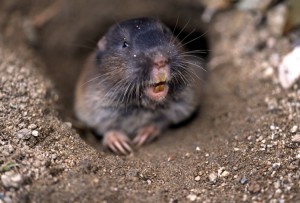Pet-Friendly Pest Control
- (541) 636-0146
- Schedule Service

If you’ve ever faced lawn damage due to burrowing creatures, you’ve likely encountered one of the usual culprits—moles and gophers. Both creatures can cause significant damage in a surprisingly short amount of time. However, these two are often confused with each other due to their similar excavatory behavior.
The first step to safeguarding your outdoor spaces begins with correctly distinguishing a gopher vs. mole scenario. This critical understanding allows you to swiftly detect an infestation in its early stages, preventing further damage to your garden. If you’re ready to become your lawn’s best protector, read on and learn more about these common garden invaders.

These subterranean creatures hold a distinctive place in the rodent family due to their unique physical attributes and habits. Here’s a comprehensive look at gophers, providing you with a detailed understanding of their overall impact on the environment.
A pocket gopher has a fur-lined pouch or “pocket” located outside its mouth. They use these pouches primarily for food storage. Gophers range in length from five to 14 inches and are covered in soft fur that varies in color from light brown to black.
Spotting gophers is as simple as walking through your yard. They’re known for their digging skills, creating intricate underground burrows and gopher holes in gardens and lawns. Gopher mounds usually have a horseshoe shape with a round plug, unlike mole mounds, which resemble cone-shaped mounds and lack a clear plug.
Gophers eat vegetation—from plant roots to shrubs and trees. They’re particularly fond of roots and soft parts of plants they come across while digging. Their dietary habits and burrowing activities can cause much damage to yards and gardens. Even a lone gopher can devastate a garden or lawn in a short time, with their tunnels causing soil erosion.
During their feeding and burrowing, a gopher may shift between 2,000 to 3,000 pounds of soil per year. They occupy an area of about 2000 square feet (0.05 acre) on average. In optimal conditions, there can be over 30 pocket gophers per acre.
A single pocket gopher can create several mounds a day, adding up to potentially 300 mounds in a year. They are mostly solitary creatures, except during breeding or rearing their young. They stay active throughout the year, with peak activity levels noticed in the spring and fall.
One of the most impressive features of pocket gophers is their teeth. Pocket gophers have large teeth with a hard biting force that can go up to 18,000 psi. This immense pressure enables gophers to chew through roots and other vegetation with ease. To put it into perspective, human bite force is only up to 200 psi, and rats up to 7,000 psi.
Gophers breed between March and June. Females often have one, sometimes two litters, each consisting of three to six young annually. The gestation period is roughly 20 days. The young, born sightless and hairless, weigh approximately half an ounce at birth. They reach independence at 40 days old but won’t breed until the next spring. In mid to late summer, young gophers leave their parents’ burrows to start burrows of their own.

Before you dug up your whole yard, chew a whole pack of juicy fruit gum, or run out of gas trying to hook your car exhaust pipe up to gopher mounds call Bug Zapper Pest Control. We provide a FREE Gopher Inspection. Let our trained technicians help with identifying gophers and other turf rodent problems. We offer guaranteed solutions.
Unlike pocket gophers, moles come from the Talpidae family and carry a unique set of characteristics optimal for underground living. To help you identify moles in your backyard, here’s an in-depth look at their biology and behavior.
Moles are usually around four to six inches long and are recognizable by their distinct, cylindrical bodies, pointed snouts, and paddle-like forelimbs. Their fur is incredibly soft and dark in color, usually black or gray. Moles do not have fur-lined pouches, and their eyes and ears are barely visible due to their adaptation to the low-light subterranean environment.
Moles create distinct tunnel networks. Their diggings appear visible as raised ridges on the surface of the yard or as circular, volcano-shaped mole mounds. They also construct deeper tunnels, typically 10 to 40 inches below the surface, serving as their main living quarters. This distinct pattern is different from gophers and is a key indicator of a mole infestation.
In contrast to gophers, moles are carnivorous. Their chief foods are earthworms, grubs, and insects, meaning your plants are mostly safe. However, their burrowing activities can disrupt root systems, causing plants to wilt or die.
Most mole species prefer to inhabit deciduous woodland areas, grasslands, and gardens. They’re known for their contribution to soil aeration and nutrient distribution due to their digging practices, though their continuous activity may also lead to lawn damage.
Moles are active year-round but demonstrate increased digging in spring and fall. These solitary animals are more sociable during the breeding season and while nurturing their young. Persistent activity throughout every season helps identify their presence in your yard.
Moles breed once a year, usually in the late winter or early spring. After a gestation period of about 42 days, a litter of three to six baby moles is born. Similar to gopher young, mole pups rely on their mother for about a month before they start digging their own tunnels.

While moles and gophers do not directly pose a threat, they can indirectly cause safety hazards. These creatures do not carry transmissible diseases. The chances of getting bitten are slim unless they’re threatened or handled inappropriately.
An indirect but significant threat lurks in the mole mounds and gopher tunnels that these burrowers incessantly dig. The uneven surfaces created can become a trip-and-fall hazard for both humans and pets, potentially leading to injuries. Their relentless burrowing can also disrupt and damage underground utility lines and irrigation systems. These disruptions can have a ripple effect, including water pool formation that could breed mosquitoes or a damaged utility line, sparking potential safety dangers.
Despite their relatively small size and harmless appearance, their potential to create significant chaos should not be underestimated. So while they may not pose a direct risk, it’s essential to combat their presence swiftly and efficiently to prevent far-reaching indirect consequences.
Learn the different ways to get rid of moles and gophers!

Understanding their behaviors and knowing the right strategies can go a long way in dealing with these pesky intruders. For homeowners looking to control or prevent an invasion of these burrowers, here are some useful tips:
While these techniques can provide a level of control, gophers and moles are persistent creatures. In case of major infestations, it’s essential to call pest control experts to ensure these burrowers are effectively removed and prevented from recurring.
Before you dig up your whole yard or run out of gas trying to hook your car exhaust pipe to gopher tunnels, call Bug Zapper Pest Control first. We provide FREE inspection for a pocket gopher infestation. Let our trained technicians help with identifying gophers and other turf rodent problems. Schedule a consultation today!



